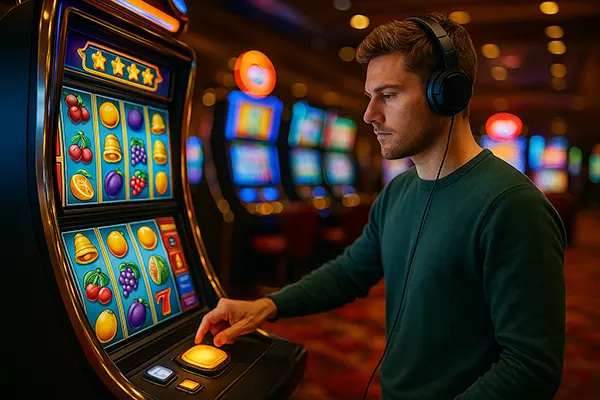The Neuroscience of Sound: How Rhythm, Tempo and Frequency Shape Betting Behaviour

Sound has always been more than mere background in gambling environments. In recent years, researchers have taken a deeper dive into how audio stimuli—specifically rhythm, tempo and frequency—directly affect decision-making processes, betting speed and session duration. By connecting neuroscience, music psychology and player behaviour, it becomes clear that soundscapes are a silent force behind many in-game actions.
How Binaural Beats Enhance Player Focus
Binaural beats involve playing two slightly different frequencies in each ear. This creates an illusion of a third tone, which the brain attempts to synchronise with. Neuroscientific studies have shown that certain frequency combinations can induce states of enhanced concentration and cognitive processing.
In the context of gambling, this heightened focus can lead to more sustained play. Gamblers may become more immersed, with fewer distractions breaking their engagement. Operators who include binaural beats subtly within audio loops might observe players staying longer, with consistent attention directed towards gameplay.
However, the effect of binaural beats varies by individual. While many find them mentally engaging, others report minimal influence. Factors such as headphone use, baseline concentration levels and session length all mediate their impact.
Scientific Basis Behind Binaural Influence
Multiple EEG-based studies have shown that theta (4–8 Hz) and alpha (8–12 Hz) frequency ranges support deep focus and mild alertness—ideal conditions for absorbing complex visuals and maintaining betting sequences. When these beats are introduced subtly during play, they can harmonise the player’s brain state with the rhythm of the game.
This harmonisation may reinforce habitual actions, such as pressing “spin” or making similar wagers, further reinforcing gameplay patterns. Nevertheless, reliance solely on binaural beats is insufficient. It works most effectively when paired with game mechanics designed to complement focused attention.
Research as of February 2025 has begun exploring adaptive sound algorithms—tools that adjust the intensity and frequency of binaural beats based on real-time EEG feedback. This next step might personalise engagement even further.
Tempo and Its Link to Faster Betting Decisions
Tempo is one of the most immediate and perceivable musical elements. Faster beats per minute (BPM) have long been associated with stimulation, while slower tempos encourage reflection. Within the gambling context, this difference can shape how quickly a player makes decisions.
Games designed with higher tempo audio—usually exceeding 120 BPM—tend to correlate with increased action frequency. Players in such environments often spin more quickly, place bets more rapidly and demonstrate shorter reaction times. This isn’t accidental; fast tempos trigger physiological arousal, elevating heart rate and mental urgency.
Such stimulation can be beneficial in short sessions but may lead to faster bankroll depletion if not balanced properly. Developers aiming for sustainability may consider tempo modulation to pace players more evenly over time.
Neural Responses to Rhythmic Stimuli
The auditory cortex processes tempo through rhythmic entrainment—a phenomenon where the brain synchronises neural oscillations with external rhythms. This entrainment accelerates decision-making speed by reducing the time needed for information processing.
Studies conducted in early 2025 confirm that rapid rhythms increase dopamine release in brain regions linked to reward anticipation. The result? A player primed for fast actions, sometimes without extensive deliberation.
Yet, tempo alone doesn’t guarantee excitement. Effective rhythm design involves fluctuating between fast and slower sequences, allowing for moments of recovery, preventing overstimulation, and supporting longer session duration.

Emotional Impact: Melancholic vs. Energetic Music
Music’s emotional tone plays a significant role in retention. Melancholic music, characterised by minor keys and slow tempos, can induce reflective moods. Conversely, energetic tracks with major keys and upbeat rhythms create excitement and urgency.
Recent behavioural analytics indicate that melancholic music may encourage longer sessions by reducing overstimulation. Players report feeling “absorbed” or “lost in thought,” maintaining gameplay without emotional fatigue. On the other hand, energetic music tends to generate more actions per minute but also shorter overall sessions.
The choice between these styles should align with the game’s intended pace. Titles that emphasise narrative or strategy benefit from ambient, melancholic scores. Meanwhile, rapid-action slots perform better when paired with energising, pulsating tracks.
Emotional Resonance and Player Loyalty
Neurologically, music influences the limbic system—the brain’s emotional centre. Minor chords activate empathy-related regions, while major chords stimulate centres associated with motivation. This direct brain-musical interaction can shape how players remember and return to a game.
Games that alternate between melancholy and high energy tend to see higher return visits. Players associate emotional variety with deeper immersion, creating a form of musical storytelling that keeps them engaged.
Designers now experiment with adaptive soundscapes, where the game responds to player behaviour—slowing down during losses, picking up speed with wins. This audio interactivity is expected to expand by the end of 2025 as personalisation becomes a key differentiator in game design.
